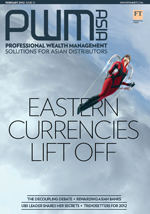New thinking to target new wealth

Banks active in Asia are rethinking client offerings, to adjust to the changing mentality of the region’s increasingly currency conscious wealthy investors
Western banks active in Asia and regional Asian players are repositioning their services. Even two years ago, there was a gung ho mentality to the banks, desperate to bring products to China and the surrounding region’s growing number of wealthy clients. It was reminiscent of money thrown at developing anything technology related in the late 1990s.
But American and European banks in particular are re-thinking their offerings. Being late to the game is no longer a disadvantage. Take Barclays Wealth, which along with competitors, will focus on servicing Chinese mainland clients using twin offshore hubs in Hong Kong and Singapore.
Rather than the advisory approach to portfolio management favoured in much of South East Asia, Barclays is finding its Northern exposure can tilt towards discretionary management. Mainland Chinese clients, argues the bank, can favour managed collective investments because they are too busy to run their own portfolios.
The psychological approach, borrowing heavily from behavioural finance, assigning a financial personality to each client to feed into the asset allocation can also be of interest. This flies in the face of the global, one-size-fits-all approach typically propagated by the American banks in Asia.
One key aspect to the way Asian portfolios are being redefined relates to currency. The formerly dollar-obsessed region is fast gaining self-confidence and discovering a new belief in its own monetary systems.
This has been aided by the gradual internationalisation of the renminbi, displayed by significant issuance of offshore ‘dim sum’ bonds in Hong Kong. Even London recently recieved Beijing’s blessing to become a trading hub for the yuan. Few private bankers across the region would bet against the RMB eventually becoming the reference currency for Asian investors.
Until that time, at least 10 years away, they are sensibly diversifying currency and investment exposures.
STRUCTURES IN SINGAPORE AND CHINA
Wherever you go in Asia, Singapore is on everybody’s lips. The Chinese are not only moving assets there in a bid to diversify sovereign risk, but they wish to escape the ‘Big Brother’ they see watching over them at home and in Hong Kong.
Singapore regulators are desperate to maintain a clean image to continue this new flow. There has been some disquiet about mis-sold structured products. But the demonstrations of disgruntled private clients in Hong Kong would not be tolerated further south.
Structured products are also starting to come under greater scrutiny on the Chinese mainland, where there is deep concern over emerging asset bubbles. Now ratings agency Fitch has highlighted the risk which wealth management activities of Chinese banks places on funding and liquidity. This was easily managed when structured product issuance was low. But today their popularity is such that they are approaching 10 per cent of total deposits.
The struggle of banks to find yields commensurate with investors’ expectations has led the China Banking Regulatory Commission to clamp down on excessive issuance of credit-backed products. Product literature rarely gives full disclosure of underlying assets. In the event of panic and mass unwinding of products, Fitch argues banks could be liable, as few would be able to prove products were sold legitimately and correctly. It is just such a scenario that Chinese authorities – conscious of triggers of public unrest – would potentially fear most.
Until now, structured products have lead to huge profits for banks in Europe, but they also proved their Achilles heel. Singapore’s Wealth Management Institute and Shanghai’s Advanced Institute of Finance must drill the downside risk doctrine into their private banking students before it is too late.




